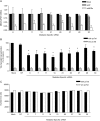Characterization of the influence of mediator complex in HIV-1 transcription
- PMID: 25100719
- PMCID: PMC4183804
- DOI: 10.1074/jbc.M114.570341
Characterization of the influence of mediator complex in HIV-1 transcription
Abstract
HIV-1 exploits multiple host proteins during infection. siRNA-based screenings have identified new proteins implicated in different pathways of the viral cycle that participate in a broad range of cellular functions. The human Mediator complex (MED) is composed of 28 elements and represents a fundamental component of the transcription machinery, interacting with the RNA polymerase II enzyme and regulating its ability to express genes. Here, we provide an evaluation of the MED activity on HIV replication. Knockdown of 9 out of 28 human MED proteins significantly impaired viral replication without affecting cell viability, including MED6, MED7, MED11, MED14, MED21, MED26, MED27, MED28, and MED30. Impairment of viral replication by MED subunits was at a post-integration step. Inhibition of early HIV transcripts was observed by siRNA-mediated knockdown of MED6, MED7, MED11, MED14, and MED28, specifically affecting the transcription of the nascent viral mRNA transactivation-responsive element. In addition, MED14 and MED30 were shown to have special relevance during the formation of unspliced viral transcripts (p < 0.0005). Knockdown of the selected MED factors compromised HIV transcription induced by Tat, with the strongest inhibitory effect shown by siMED6 and siMED14 cells. Co-immunoprecipitation experiments suggested physical interaction between MED14 and HIV-1 Tat protein. A better understanding of the mechanisms and factors controlling HIV-1 transcription is key to addressing the development of new strategies required to inhibit HIV replication or reactivate HIV-1 from the latent reservoirs.
Keywords: Host Factor; Human Immunodeficiency Virus (HIV); RNA Polymerase II; RNA Silencing; RNAP II; Tat; Transcription; Viral Transcription.
© 2014 by The American Society for Biochemistry and Molecular Biology, Inc.
Figures






Similar articles
-
Modulating HIV-1 replication by RNA interference directed against human transcription elongation factor SPT5.Retrovirology. 2004 Dec 27;1:46. doi: 10.1186/1742-4690-1-46. Retrovirology. 2004. PMID: 15620346 Free PMC article.
-
Semen Exosomes Promote Transcriptional Silencing of HIV-1 by Disrupting NF-κB/Sp1/Tat Circuitry.J Virol. 2018 Oct 12;92(21):e00731-18. doi: 10.1128/JVI.00731-18. Print 2018 Nov 1. J Virol. 2018. PMID: 30111566 Free PMC article.
-
Inhibition of human immunodeficiency virus type 1 replication by RNA interference directed against human transcription elongation factor P-TEFb (CDK9/CyclinT1).J Virol. 2004 Mar;78(5):2517-29. doi: 10.1128/jvi.78.5.2517-2529.2004. J Virol. 2004. PMID: 14963154 Free PMC article.
-
Role of Host Factors on the Regulation of Tat-Mediated HIV-1 Transcription.Curr Pharm Des. 2017;23(28):4079-4090. doi: 10.2174/1381612823666170622104355. Curr Pharm Des. 2017. PMID: 28641539 Free PMC article. Review.
-
The role of Tat in HIV-1 replication: an activator and/or a suppressor?AIDS Rev. 2002 Jan-Mar;4(1):41-9. AIDS Rev. 2002. PMID: 11998784 Review.
Cited by
-
A single-molecule view of transcription reveals convoys of RNA polymerases and multi-scale bursting.Nat Commun. 2016 Jul 27;7:12248. doi: 10.1038/ncomms12248. Nat Commun. 2016. PMID: 27461529 Free PMC article.
-
IRF7 expression correlates with HIV latency reversal upon specific blockade of immune activation.Front Immunol. 2022 Sep 5;13:1001068. doi: 10.3389/fimmu.2022.1001068. eCollection 2022. Front Immunol. 2022. PMID: 36131914 Free PMC article.
-
Genome-Wide Association Study in Vestibular Neuritis: Involvement of the Host Factor for HSV-1 Replication.Front Neurol. 2018 Jul 20;9:591. doi: 10.3389/fneur.2018.00591. eCollection 2018. Front Neurol. 2018. PMID: 30079052 Free PMC article.
-
RNA editing by ADAR1 regulates innate and antiviral immune functions in primary macrophages.Sci Rep. 2017 Oct 17;7(1):13339. doi: 10.1038/s41598-017-13580-0. Sci Rep. 2017. PMID: 29042669 Free PMC article.
-
Survival-based CRISPR genetic screens across a panel of permissive cell lines identify common and cell-specific SARS-CoV-2 host factors.Heliyon. 2023 Jan;9(1):e12744. doi: 10.1016/j.heliyon.2022.e12744. Epub 2022 Dec 30. Heliyon. 2023. PMID: 36597481 Free PMC article.
References
-
- Ballana E., Esté J. A. (2013) Insights from host genomics into HIV infection and disease: identification of host targets for drug development. Antiviral Res. 100, 473–786 - PubMed
-
- Marcello A., Zoppé M., Giacca M. (2001) Multiple modes of transcriptional regulation by the HIV-1 Tat transactivator. IUBMB Life 51, 175–181 - PubMed
-
- Kao S. Y., Calman A. F., Luciw P. A., Peterlin B. M. (1987) Anti-termination of transcription within the long terminal repeat of HIV-1 by tat gene product. Nature 330, 489–493 - PubMed
Publication types
MeSH terms
Substances
LinkOut - more resources
Full Text Sources
Other Literature Sources
Medical

